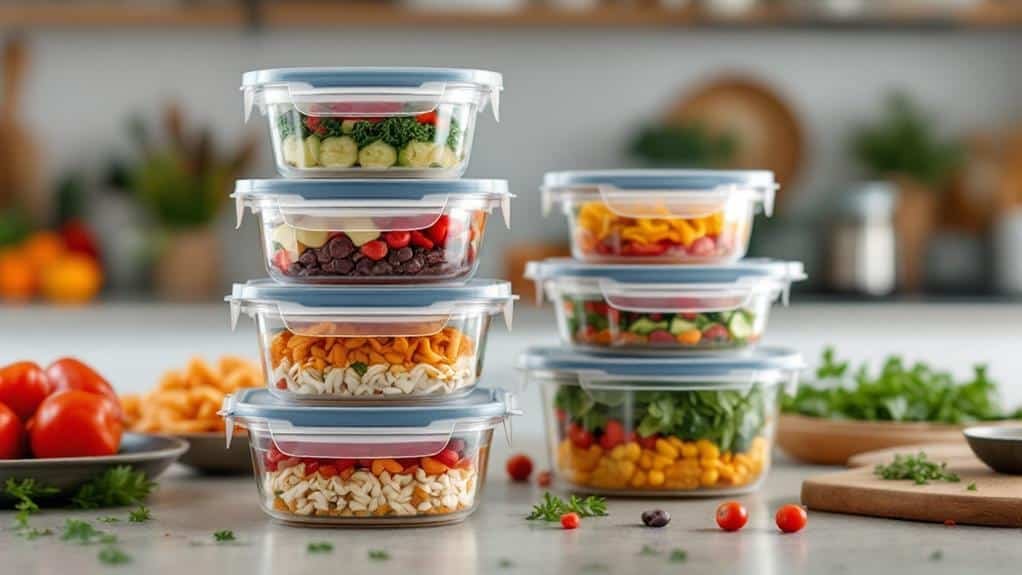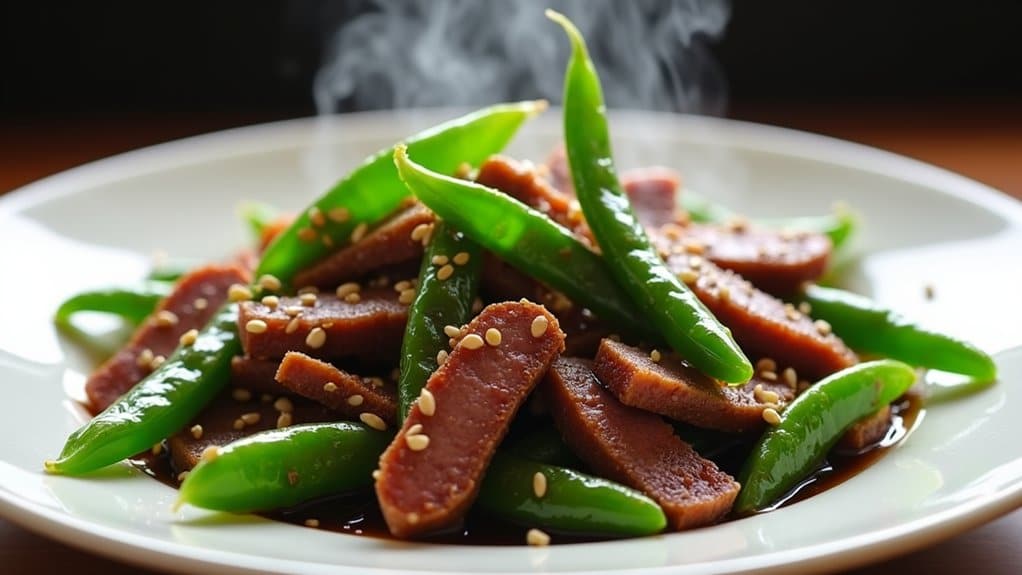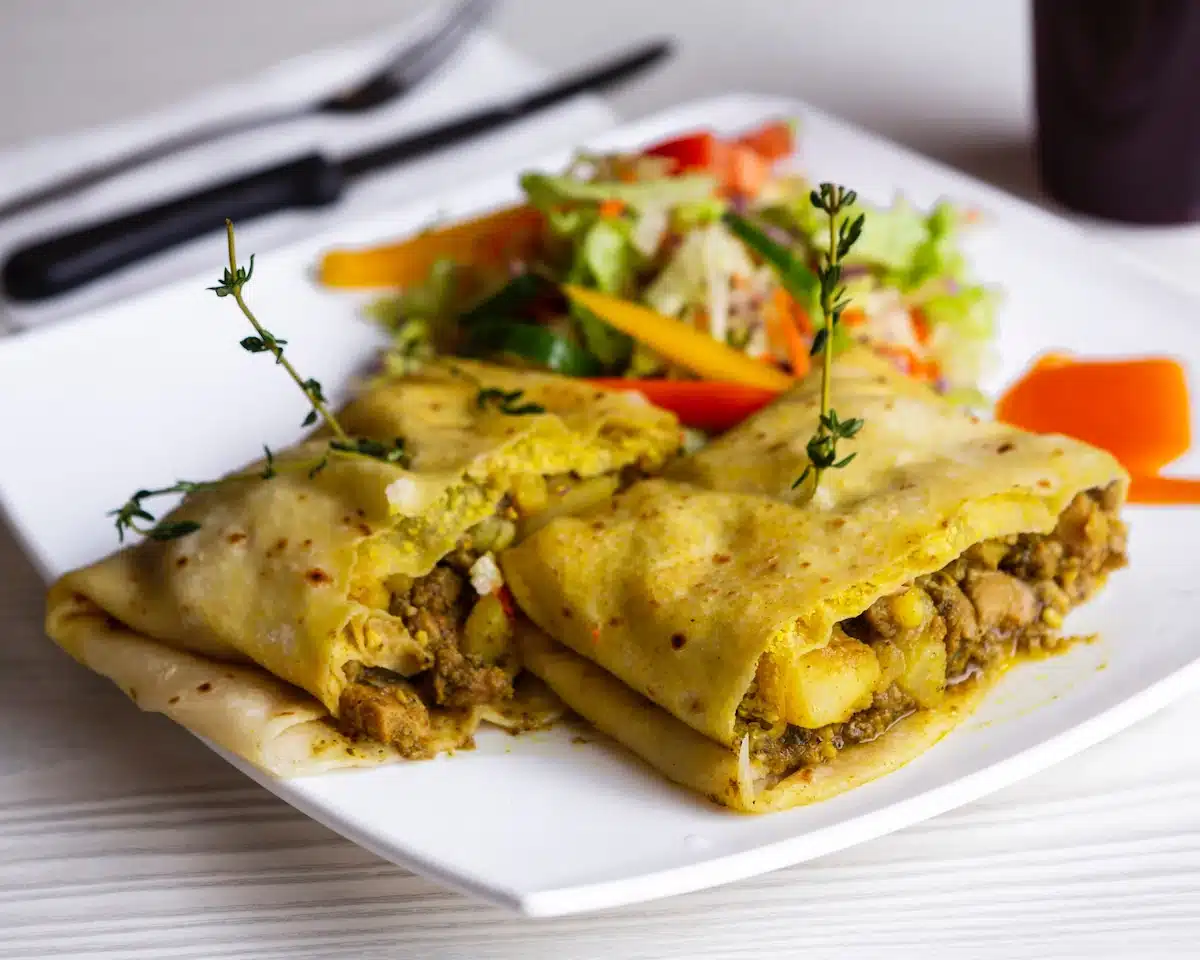You’ll love this diabetic-friendly stir-fry that puts you in control of your meal while savoring authentic Asian flavors. Start with lean chicken breast, which keeps blood sugar stable, and add a rainbow of vegetables like broccoli, carrots, and snow peas for essential nutrients. The light sauce combines low-sodium soy sauce, fresh ginger, and garlic, creating a perfect balance of taste without compromising health goals. This versatile dish takes just 35 minutes from prep to plate, serves 4, and packs 28g of protein per serving. Let’s explore how this 2,000-year-old cooking technique can transform your weekly menu.
History of Stir-Frying
While stir-frying dates back over 2,000 years to China’s Han Dynasty, diabetic-friendly versions of chicken stir-fry emerged in the late 20th century as nutritionists began adapting traditional recipes for specific dietary needs.
You’ll find that this dish’s culinary origins blend seamlessly with modern health consciousness. In ancient China, quick cooking over high heat wasn’t just about flavor – it was practical during times of fuel shortages. Who knew our ancestors were accidentally creating such a health-conscious cooking method?
Western nutritionists finally recognized the health benefits of stir-frying in the 1980s. You’ll appreciate how they discovered this cooking technique preserves nutrients while using minimal oil – perfect for managing blood sugar levels. Today, you’re benefiting from centuries of culinary evolution combined with modern dietary science.
Chicken and Vegetable Stir-Fry for Diabetics Recipe

Chicken and Vegetable Stir-Fry for Diabetics
This diabetic-friendly stir-fry combines lean chicken breast with colorful vegetables in a light sauce that’s low in sugar and carbohydrates. The dish takes 15 minutes to prepare and can be made ahead by chopping the vegetables and storing them in the refrigerator.
For efficient preparation, using a food processor’s slicing discs can reduce vegetable prep time to under 30 seconds while ensuring uniform cuts.
Total cooking time is 20 minutes, making this an ideal weeknight dinner option. The recipe serves four people and can be stored in an airtight container in the refrigerator for up to 2 days.
Savory Diabetic-Friendly Chicken and Vegetable Stir-Fry in 35 Minutes
Ingredients
- 1 pound skinless boneless chicken breast, cut into 1-inch pieces
- 2 cups broccoli florets
- 1 red bell pepper sliced
- 1 cup snap peas
- 1 cup carrots julienned
- 2 tablespoons low-sodium soy sauce
- 1 tablespoon rice vinegar
- 1 tablespoon fresh ginger minced
- 2 cloves garlic minced
- 2 tablespoons olive oil
- 1/4 cup low-sodium chicken broth
- 1 tablespoon cornstarch
- Salt and pepper to taste
Equipment
- Large wok or deep skillet
- Sharp Knife
- Measuring cups and spoons
- Small bowl (for sauce mixture)
- Tongs (optional, for stir-frying)
Method
- Prepare Your Cooking Station:
- Clear and sanitize your workspace.
- Arrange all pre-measured ingredients in small bowls for quick access.
- Slice Chicken and Vegetables:
- Slice chicken breast into uniform 1-inch pieces.
- Chop all vegetables into similar-sized pieces for even cooking.
- Make the Sauce:
- In a small bowl, whisk together chicken broth and cornstarch until smooth.
- Stir in soy sauce and rice vinegar.
- Stir-Fry the Chicken:
- Heat 1 tablespoon olive oil in the wok over medium-high heat.
- Add chicken and cook until golden brown and cooked through, about 5–7 minutes.
- Remove chicken from the wok and set aside.
- Stir-Fry the Vegetables:
- Add remaining olive oil to the wok.
- Add garlic and ginger, stir for 30 seconds until fragrant.
- Add broccoli, bell pepper, snap peas, and carrots. Stir-fry for 3–4 minutes until vegetables are crisp-tender.
- Combine and Finish:
- Return chicken to the wok.
- Pour in the sauce mixture.
- Stir-fry for 2–3 minutes, or until the sauce thickens and everything is well coated.
- Season with salt and pepper to taste.
- Serve:
- Serve immediately. For a lower-carb meal, enjoy as is or pair with cauliflower rice.
Nutrition
Notes
- Use low-sodium soy sauce to reduce sodium content.
- Avoid adding sugar; if a sweeter sauce is desired, use a sugar substitute like stevia or erythritol.
- Focus on non-starchy vegetables to keep carbohydrates low.
- Monitor portion sizes to help manage blood glucose.
- Serve with cauliflower rice or a small portion of brown rice for extra fiber and lower glycemic impact.
Tried this recipe?
Let us know how it was!For best results, verify all ingredients are cut into similar-sized pieces for even cooking. Substitute vegetables based on availability and preference, maintaining similar portions. If blood sugar control is a priority, monitor portion sizes and pair with brown rice or cauliflower rice. Pre-measure all ingredients before starting to cook as stir-frying moves quickly.
Cooking Steps
You’ll want to start by preparing your cooking station, with all ingredients measured, chopped, and within arm’s reach. Before heating up your wok, you’ll need to slice your chicken into thin, uniform strips and cut your fresh vegetables into similarly-sized pieces for even cooking. Once your prep work is done, you’re ready to fire up that wok until it’s smoking hot, which is when the real magic of stir-frying begins.
Step 1. Prepare the Cooking Station Thoroughly

Setting up your cooking station properly takes three key steps before starting this diabetic-friendly stir-fry.
First, you’ll want to clear and sanitize your countertop space, creating distinct zones for kitchen organization. Set up your cutting board on the left, mixing bowls in the center, and your wok or large skillet on the right. This flow makes ingredient preparation much smoother.
Next, gather all your tools: a sharp knife, measuring spoons, a wooden spatula, and tongs. Nothing’s worse than scrambling for utensils once your wok is sizzling hot!
Finally, arrange your pre-measured ingredients in small bowls according to when you’ll use them. I like to line mine up like a cooking show – it makes me feel like a pro chef while ensuring I don’t forget anything in the heat of the moment.
Step 2. Slice Chicken Into Strips

Grab your sharp knife and begin slicing 1 pound of boneless, skinless chicken breast into uniform strips about 1/4 inch thick. For the best knife techniques, place your palm flat on top of the chicken breast to hold it steady, keeping your fingers tucked safely away from the blade. If the chicken’s still a bit frozen, you’ll find it’s actually easier to get clean cuts.
Before you start slicing, consider marinating the chicken as your next step. Those uniform strips you’re creating will absorb flavors better, making your stir-fry more delicious. Like my grandmother always said, “The thinner the slice, the nicer the spice!”
Try slicing slightly against the grain at a 45-degree angle to get consistent strips. This technique guarantees tender pieces that’ll cook evenly in your diabetic-friendly dish.
Step 3. Chop Fresh Vegetables Precisely

Fresh vegetables await their transformation into perfectly sized pieces for this diabetic-friendly stir-fry. Your chopping techniques will make all the difference in how evenly your dish cooks and how appealing it looks on the plate.
Check your vegetable freshness before you begin – crisp, vibrant produce will give you the best results. Then, grab your sharp knife and cutting board to create uniform pieces:
- Cut broccoli into bite-sized florets about 1.5 inches across
- Slice carrots diagonally into 1/4-inch thick oval shapes
- Trim snow peas, removing any tough strings along the edges
- Dice bell peppers into 1-inch squares, removing seeds and membranes
Using a stainless steel peeler for your carrots will ensure rust-resistant, consistently sharp performance throughout your prep work.
Step 4. Heat the Wok Until Smoking
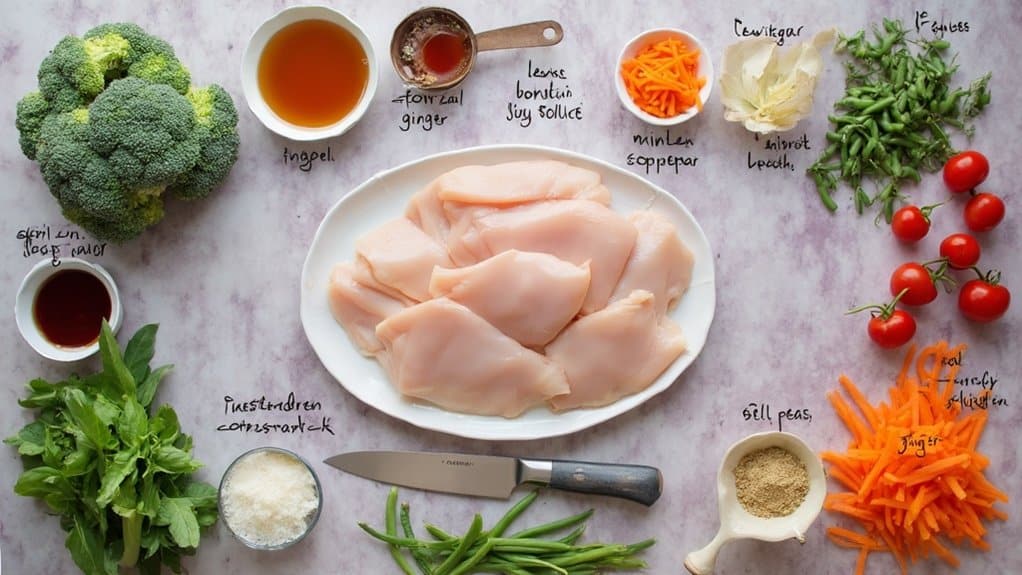
A properly heated wok forms the foundation of successful stir-frying. You’ll know your wok is ready when you see a wisp of smoke rising from its surface. This vital wok heating step guarantees your ingredients sear quickly instead of steaming.
Place your wok over high heat and let it warm up for about 2-3 minutes. Try the water droplet test – if a drop evaporates within a second, you’re good to go. Don’t rush this step; patience here pays off with better results.
Step 5. Add Sauce and Serve
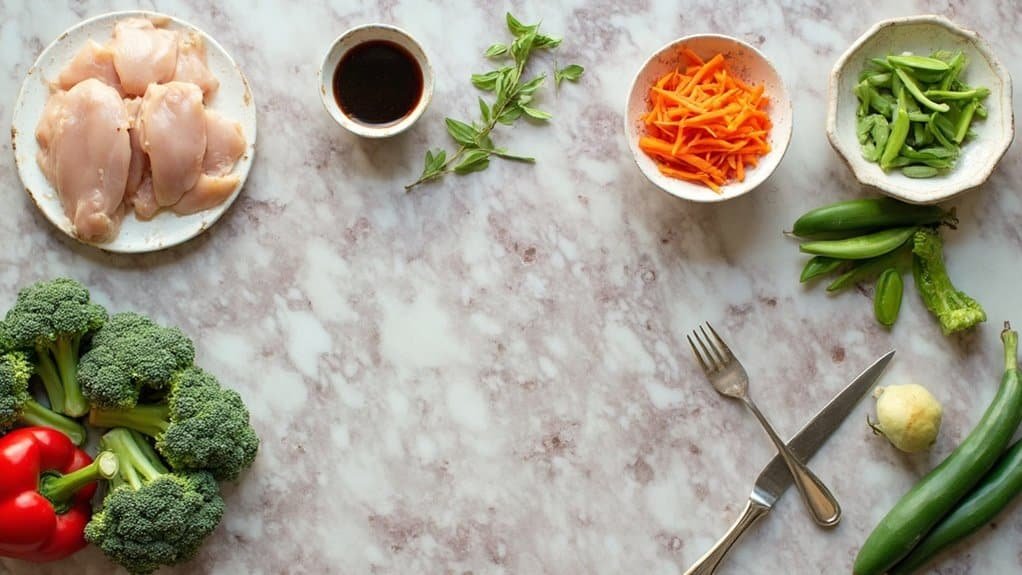
Pour your homemade diabetic-friendly sauce into the sizzling wok, letting it coat the chicken and vegetables evenly. Stir continuously for 30 seconds until the sauce thickens and turns glossy. You’ll know it’s ready when it clings beautifully to your ingredients.
For extra flavor and variety, try these sauce variations:
- Lemon-ginger: Add fresh lemon zest and extra ginger for a zesty kick
- Garlic-herb: Mix in fresh basil and extra minced garlic
- Spicy Asian: Include a dash of sugar-free sweet chili sauce
- Orange-sesame: Add orange zest and a sprinkle of toasted sesame seeds
Serving suggestions? I love plating this over cauliflower rice for a low-carb option. You can also serve it alongside brown rice or zucchini noodles – whatever fits your meal plan best.
Summing it up
Creating this diabetic-friendly chicken and vegetable stir-fry doesn’t require advanced culinary skills. You’ve learned how to transform simple ingredients into a delicious, health-conscious meal that’ll keep your blood sugar in check while satisfying your taste buds.
For even better results, consider preparing this dish in an air fryer with EvenCrisp technology to achieve optimal crispiness while using up to 98% less oil than traditional cooking methods.
This versatile dish offers incredible health benefits, from lean protein to fiber-rich vegetables. You can easily adapt it for meal prep by making larger batches and storing portions for busy weekdays. Just remember to keep your vegetables crisp-tender for the best reheating results.
Now that you’ve mastered this basic recipe don’t be afraid to experiment with different vegetable combinations or protein options. Whether you’re cooking for yourself or your family, you’ve got a reliable, diabetes-friendly meal that proves healthy eating can be both simple and delicious.
To Sum it Up
With this diabetic-friendly stir-fry, you’ve got an excellent foundation for healthy eating. By choosing lean protein, vibrant veggies, and a lighter sauce, you’re taking control of your blood sugar while enjoying a delicious meal. Don’t be afraid to experiment with different vegetable combinations or seasonings—that’s the beauty of stir-frying. Remember, managing diabetes doesn’t mean sacrificing flavor. This versatile dish proves you can have both!





